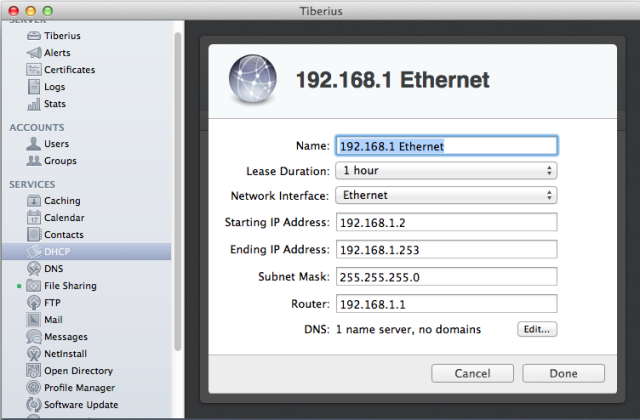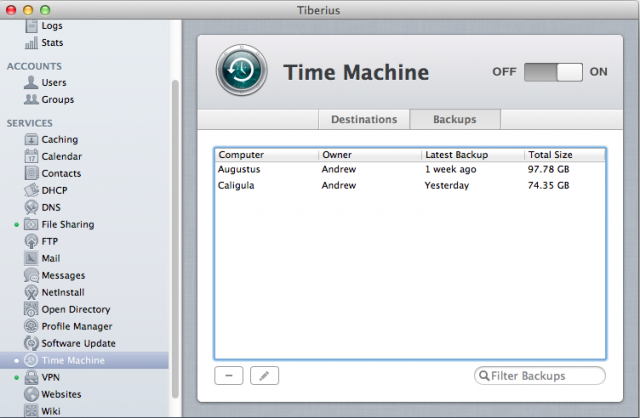It has now been roughly half a year since the release of Mountain Lion. If Apple sticks to its new yearly release cadence for new OS X versions, that means we're probably about halfway to OS X 10.9. That doesn't mean the OS has stood still, though—two point updates have since tweaked the operating system's functionality and stability, and this is even more true of OS X's buttoned-up cousin, OS X Server.
While Windows Server rarely picks up major new features outside of service packs, OS X Server is like the client version of OS X in that it sometimes takes a couple of point updates for its features to stabilize. Since July, we've received two point updates for OS X Server, and they've changed things around enough that it merits revisiting our original guide and pointing out what has changed.
We'll be focusing on the major user-facing changes here, but for a complete list of everything that has been changed and fixed you may also want to look at the complete release notes for OS X Server 2.1.1 and 2.2.
DHCP

As we've discussed, Lion and Mountain Lion have been slowly migrating features from the older but more feature-rich Server Admin Tools apps to the simpler but more user-friendly Server.app. In that process, several services have gone missing, either removed from the product completely or relegated to the command line.
In the original release, the DHCP service was one of those that had vanished, but it has since been restored to Server.app. Like the other OS X Server services, DHCP is aimed toward people who have some idea of how networking works but don't have much server administration experience.
It's a reasonably capable way to replace your router's built-in DHCP capabilities—it allows you to configure multiple subnets on different physical network interfaces (or VLANs, for Macs with only one physical network interface), configure your DHCP ranges, set DHCP lease time, reserve specific IP addresses for specific clients, and view information on connected clients. Depending on your router's firmware, you may actually have more network configuration options there than OS X gives you, but for homes or small businesses it's nice to have all of these settings available in one simple tool, especially if you're using it in conjunction with the DNS service and don't want to have to jump around between different administration tools.
Profile manager

The Profile Manager is one of OS X Server's most useful features, since it allows administrators to control settings and install applications on multiple OS X and iOS clients at once. Between versions 2.0 and 2.2, it has picked up several features that should appeal to IT admins looking to lock their systems down.
Specifically, it restricts access to the Mac App Store: you can restrict your users' access to the store to disallow the purchase and download of new applications while also allowing updates for currently installed applications to come through. Administrators can also now delete applications uploaded to the Profile Manager (which seemed like a strange oversight on Apple's part, but hey, at least it's fixed now).
One other new feature, called the "caching service" in Apple's documentation, exists somewhere between the Profile Manager and the Software Update service: in addition to caching new and past updates for the core Apple software that's part of every OS X install, servers with the Software Update service enabled will download and cache updates to Mac App Store apps you've purchased for your systems, further saving bandwidth if you've purchased apps like Pages or Numbers en masse.
Finally, if your OS X Server and its Open Directory are integrated with a Windows Active Directory server, you can now use your already-configured Active Directory groups in Profile Manager to distribute settings and apps, rather than recreating these groups solely for use with your Macs and iOS devices.
Time Machine

The operation of the Time Machine service remains simple: it's an easy way to offer backup services to a handful of Macs in the absence of an external hard drive or a home NAS device. In the updates since launch, the page in Server.app has gotten a bit more useful: you can now see the amount of free space on your backup volumes easily in the Destinations tab, and the Backups tab will show you what machines are backing up to your server, how much space they're using, the owner of the system in question, the encryption status of the backup, and how long it's been since the last backup. With the backup date checking also comes a new server alert, which will tell you when computers connected to your Time Machine server haven't backed up in ten or more days.
Our wish list for the Time Machine service is still quite long—none of this is quite as useful as user- or computer-specific Time Machine disk quotas, server-specified backup intervals, and server-side exceptions for files and folders would be. Given that there was no change in the Time Machine service between 10.7.5 and 10.8.0, however, there are nice (if belated) additions.
Conclusions, and thoughts on the future
You may have noticed that the App Store download for OS X Server is labeled version 2.2, in spite of the fact that OS X Server has been around since before the client version of the software was available to consumers. This refers specifically to Server.app, the simplified administration console introduced in Lion as version 1.0.
As we mused in our original guide, the Server application has now been decoupled from the core operating system, and the two update independently of one another—Server 2.1 was issued at about the same time as the OS X 10.8.2 update, but Server 2.2 was released some months after and there's no version of Server 2.3 slated to come out alongside the imminent OS X 10.8.3 update (at least if Apple's developer site is any indication).
This has a couple of implications, most obviously the fact that you no longer need to install potentially service-breaking updates to Server.app to install the latest OS X security updates on your system—in versions 10.0 through 10.7, OS X Server got its own delta and combo updaters that bundled all of the Server stuff in with fixes for the core OS.
The second (and slightly more speculative) implication is that OS X Server updates may no longer track with updates to OS X itself. We may see a new Server 3.0 app released alongside OS X 10.9 when it comes out later this year, but we may also simply see a new Server 2.x release that ensures all of the existing services continue to work with new Macs. Given the incremental changes and updates between OS X Server 10.7 and 10.8 (and the changes that have continued to trickle in since 10.8.2), we could be looking at a future where OS X Server development is more Chrome-like: progression through relatively frequent but minor updates, rather than large all-at-once pushes for major new features.
At any rate, the changes we've outlined here are just a few of the new things included in the last two OS X Server point updates—plenty of other security and stability tweaks have been made, and they should hopefully prevent you from having some of the scattered stability issues we mentioned in our original guide. Other changes have been made specifically to resolve issues for people who are upgrading to Mountain Lion from an older version of OS X Server—once again, you should check the release notes for update 2.1.1 and 2.2 to see if you've been wrestling with a particular problem that now claims to be solved.
reader comments
38